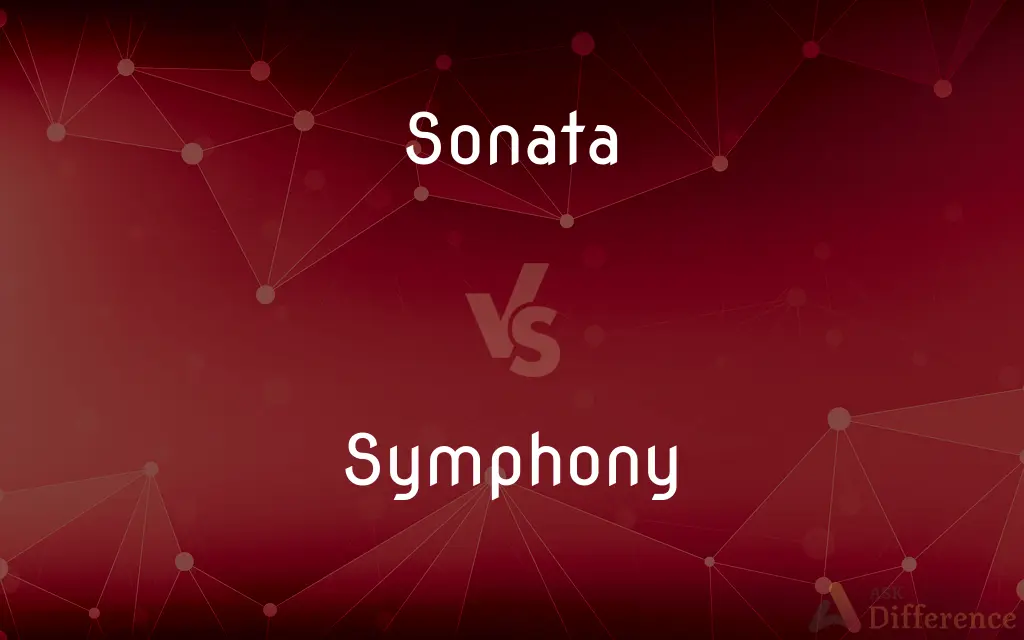Sonata vs. Symphony — What's the Difference?
Edited by Tayyaba Rehman — By Urooj Arif — Updated on April 4, 2024
A sonata is a musical composition for one or more solo instruments, often structured in three or four movements with contrasting themes. A symphony is elaborate orchestral composition, typically in four movements, that explores a wide range of emotions.

Difference Between Sonata and Symphony
Table of Contents
ADVERTISEMENT
Key Differences
A sonata, originating in the Classical period, is designed primarily for a solo instrument, like the piano, or a duo, such as a violin and piano. Its structure usually involves multiple movements that contrast in tempo and character, commonly adhering to a fast-slow-fast format. This form allows for expressive depth and thematic development within a relatively intimate setting. On the other hand, a symphony is a larger-scale composition that employs a full orchestra, including strings, woodwinds, brass, and percussion. Symphonies are known for their complexity and emotional breadth, exploring a wide array of themes and motifs across its movements, which traditionally include fast, slow, minuet or scherzo, and final fast movements.
Sonatas offer musicians a platform for individual expression and technical prowess, often serving as a showcase for the performer's skill and interpretative abilities. Each movement within a sonata can present different challenges and thematic materials, requiring both technical skill and emotional insight. Conversely, symphonies provide a collective musical experience, demonstrating the power and color of an orchestra. They are the result of intricate collaboration among various sections of the orchestra, under the unifying vision of the conductor, to bring to life the composer's thematic explorations and variations.
In terms of historical significance, both sonatas and symphonies have been pivotal in the evolution of classical music. Sonatas were central to the development of instrumental music in the 18th century, with composers like Beethoven expanding the form to express a broader range of emotions and ideas. Symphonies became the epitome of orchestral music in the Classical and Romantic periods, with composers such as Haydn, Mozart, and Beethoven pushing the boundaries of the form in terms of scale, complexity, and expressive scope.
While sonatas are more focused and intimate, symphonies are expansive and communal. The former relies on the subtlety and nuance of individual or duo performances to convey its musical ideas, whereas the latter utilizes the full spectrum of orchestral sounds to create a rich tapestry of musical expression. This difference in scale and scope reflects the unique qualities and possibilities of each form.
Both sonatas and symphonies are crucial to understanding the development of Western classical music. They represent two of the most important and influential forms in the classical repertoire, each with its own conventions, challenges, and expressive opportunities. While they differ in instrumentation, scale, and the experience they offer the listener, both are integral to the classical tradition, providing insights into the historical and aesthetic evolution of music.
ADVERTISEMENT
Comparison Chart
Definition
A composition for one or more solo instruments.
An elaborate orchestral composition.
Structure
Typically in three or four movements with contrasting themes.
Usually in four movements, exploring a range of emotions.
Instrumentation
Solo or duo, e.g., piano, violin and piano.
Full orchestra, including strings, woodwinds, brass, and percussion.
Expressive Scope
Intimate, showcasing individual expression and technical skill.
Expansive, with a wide array of themes and emotional depth.
Performance Context
More focused and personal, suitable for recitals.
Grand and communal, designed for concert hall performances.
Compare with Definitions
Sonata
Allows for intimate expression and technical exploration.
Chopin’s sonatas are masterclasses in piano expression.
Symphony
A collaborative effort that highlights the orchestra's collective talent.
Performing a symphony requires precise coordination and interpretation by the entire orchestra.
Sonata
Often includes fast, slow, and fast movements.
The structure of a classical sonata balances contrast and cohesion.
Symphony
Moves through contrasting themes and moods.
Tchaikovsky’s symphonies are celebrated for their emotional depth.
Sonata
A musical piece for one or two instruments, featuring multiple contrasting movements.
Beethoven's Moonlight Sonata is a staple of piano repertoire.
Symphony
Combines a wide array of instruments for a rich sound palette.
Mahler’s symphonies utilize large orchestras for a monumental sound.
Sonata
Designed to explore thematic development within a compact form.
Mozart’s violin sonatas are celebrated for their lyrical beauty.
Symphony
An extended orchestral composition, typically in four movements.
Beethoven’s Ninth Symphony is known for its complexity and emotional range.
Sonata
Showcases the performer's skill and interpretative depth.
Performing a sonata demands both technical precision and emotional insight.
Symphony
The epitome of classical orchestral music, showcasing the composer’s and orchestra’s abilities.
Brahms’ symphonies are admired for their structural genius.
Sonata
Sonata (; Italian: [soˈnaːta], pl. sonate; from Latin and Italian: sonare [archaic Italian; replaced in the modern language by suonare], "to sound"), in music, literally means a piece played as opposed to a cantata (Latin and Italian cantare, "to sing"), a piece sung.
Symphony
A symphony is an extended musical composition in Western classical music, written by composers, most often for orchestra. Although the term has had many meanings from its origins in the ancient Greek era, by the late 18th century the word had taken on the meaning common today: a work usually consisting of multiple distinct sections or movements, often four, with the first movement in sonata form.
Sonata
A composition for one or more solo instruments, one of which is usually a keyboard instrument, usually consisting of three or four independent movements varying in key, mood, and tempo.
Symphony
An extended piece in three or more movements for symphony orchestra.
Sonata
(music) A musical composition for one or a few instruments, one of which is frequently a piano, in three or four movements that vary in key and tempo.
Symphony
An instrumental passage in a vocal or choral composition.
Sonata
An extended composition for one or two instruments, consisting usually of three or four movements; as, Beethoven's sonatas for the piano, for the violin and piano, etc.
Symphony
An instrumental overture or interlude, as in early opera.
Sonata
A musical composition of 3 or 4 movements of contrasting forms
Symphony
A symphony orchestra.
Symphony
An orchestral concert.
Symphony
Harmony, especially of sound or color.
Symphony
Something characterized by a harmonious combination of elements.
Symphony
An extended piece of music of sophisticated structure, usually for orchestra.
Symphony
(music) An instrumental introduction or termination to a vocal composition.
Symphony
Harmony in music or colour, or a harmonious combination of elements.
Symphony
A symphony orchestra.
Symphony
A consonance or harmony of sounds, agreeable to the ear, whether the sounds are vocal or instrumental, or both.
The trumpets sound,And warlike symphony in heard around.
Symphony
A stringed instrument formerly in use, somewhat resembling the virginal.
With harp and pipe and symphony.
Symphony
An elaborate instrumental composition for a full orchestra, consisting usually, like the sonata, of three or four contrasted yet inwardly related movements, as the allegro, the adagio, the minuet and trio, or scherzo, and the finale in quick time. The term has recently been applied to large orchestral works in freer form, with arguments or programmes to explain their meaning, such as the "symphonic poems" of Liszt. The term was formerly applied to any composition for an orchestra, as overtures, etc., and still earlier, to certain compositions partly vocal, partly instrumental.
Symphony
A long and complex sonata for symphony orchestra
Symphony
A large orchestra; can perform symphonies;
We heard the Vienna symphony
Common Curiosities
Why are symphonies considered more grand and communal than sonatas?
Symphonies, with their use of a full orchestra and exploration of a wide range of emotions and themes, naturally lend themselves to grander and more communal experiences than the more intimate sonatas.
What is the main difference between a sonata and a symphony?
The main difference lies in their scale and instrumentation: a sonata is for solo or duo performers, focusing on individual expression, while a symphony is for a full orchestra, offering a broader and more complex musical experience.
How has the sonata form influenced the development of the symphony?
Sonata form, with its emphasis on thematic development and contrast, has been foundational in shaping the structure and expressive approach of symphonies.
Can the same musical themes appear in sonatas and symphonies?
Yes, composers often explore similar themes across different forms, including sonatas and symphonies, adapting them to the specific demands and possibilities of each.
Can both sonatas and symphonies tell a story or convey a specific idea?
Yes, both forms can be narrative or programmatic, conveying stories, ideas, or emotional journeys, though the scale and means of expression will differ.
Why are sonatas important in music education and training?
Sonatas are key in developing a musician’s technical skills, expressive capabilities, and understanding of musical structure and thematic development.
How do historical contexts influence the evolution of sonatas and symphonies?
Historical and cultural contexts have shaped the thematic content, structural innovations, and expressive aims of both sonatas and symphonies, reflecting changing tastes and ideas.
Can a composer integrate elements of a sonata into a symphony?
Yes, composers often blend elements across forms, such as using sonata form within a symphony’s movement or incorporating symphonic concepts into a sonata.
What innovations have contemporary composers introduced to these forms?
Contemporary composers have experimented with extending the forms, integrating electronic elements, and challenging traditional structures to reflect modern themes and technologies.
What skills are essential for composers writing sonatas and symphonies?
Composers need a deep understanding of instrumentation, thematic development, and structural coherence, with skills adapted to the specific demands of each form.
How do audiences’ experiences differ when listening to sonatas versus symphonies?
Audiences might find sonatas more intimate and focused, offering a direct connection with the performer’s expression, while symphonies provide a more immersive and varied sonic experience.
How do performers’ roles differ when playing a sonata versus a symphony?
In a sonata, performers have a more individualized role, focusing on personal expression and interaction, while in a symphony, musicians collaborate under a conductor’s guidance to achieve a unified interpretation.
What role does improvisation play in sonatas and symphonies?
Historically, improvisation played a role in performance, especially in cadenzas of concertos (related to sonatas); in symphonies, it’s less common due to the complexity and coordination required.
How do ensembles vary between sonatas and symphonies?
Sonatas are performed by soloists or duos, focusing on a more personal form of expression, while symphonies involve large orchestral ensembles for a collective performance.
What makes a sonata or a symphony iconic or historically significant?
Iconic sonatas and symphonies are often those that have pushed the boundaries of the form, showcased extraordinary thematic development, or captured the cultural and emotional zeitgeist of their time.
Share Your Discovery

Previous Comparison
Mmap vs. Malloc
Next Comparison
Rest vs. StayAuthor Spotlight
Written by
Urooj ArifUrooj is a skilled content writer at Ask Difference, known for her exceptional ability to simplify complex topics into engaging and informative content. With a passion for research and a flair for clear, concise writing, she consistently delivers articles that resonate with our diverse audience.
Edited by
Tayyaba RehmanTayyaba Rehman is a distinguished writer, currently serving as a primary contributor to askdifference.com. As a researcher in semantics and etymology, Tayyaba's passion for the complexity of languages and their distinctions has found a perfect home on the platform. Tayyaba delves into the intricacies of language, distinguishing between commonly confused words and phrases, thereby providing clarity for readers worldwide.














































